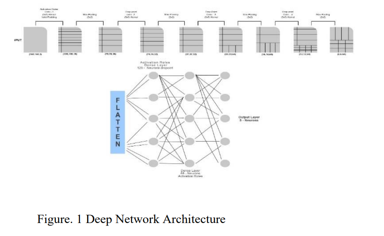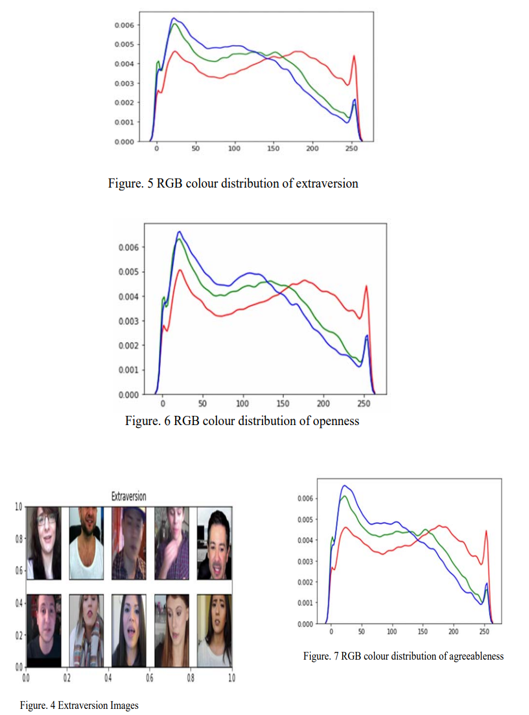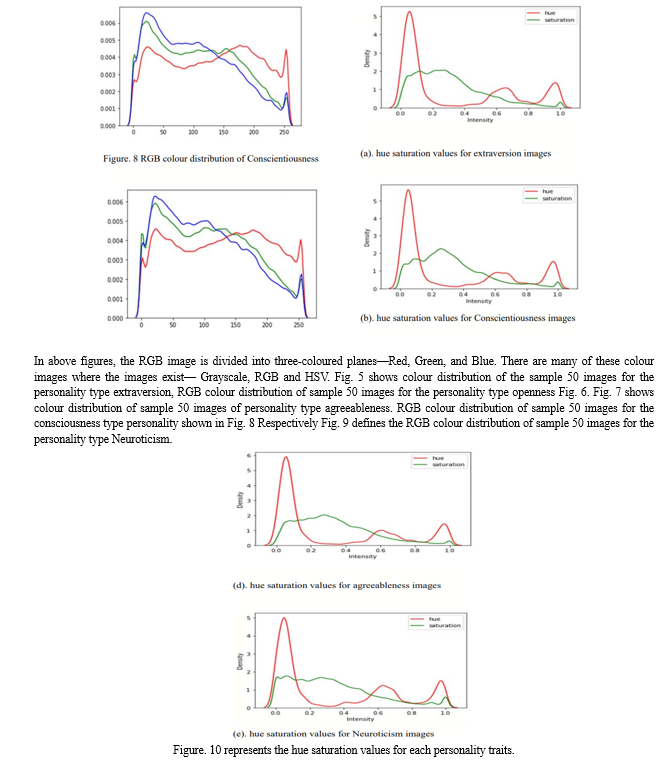Ijraset Journal For Research in Applied Science and Engineering Technology
- Home / Ijraset
- On This Page
- Abstract
- Introduction
- Conclusion
- References
- Copyright
A Deep Learning Model for Predicting User Personality Using Social Media
Authors: Misfer Shaikh, Zakaria Basar
DOI Link: https://doi.org/10.22214/ijraset.2024.58532
Certificate: View Certificate
Abstract
Social media is a form of communication based on the internet to share information through content and images. Their choice of profile images and type of image they post can be closely connected to their personality. The user posted images are designated as personality traits. The objective of this study is to predict five factor model personality dimensions from profile images by using deep learning and neural networks. Developed a deep learning framework-based neural network for personality prediction. The personality types of the Big Five Factor model can be quantified from user profile images. To measure the effectiveness, proposed two models using convolution Neural Networks to classify each personality of the user. Done performance analysis among two different models for efficiently predict personality traits from profile image. It was found that VGG-69 CNN models are best performing models for producing the classification accuracy of 91% to predict user personality traits. Keywords Personality Traits, Classification, Deep Learning, Convolution Neural Networks, Five Factor Model
Introduction
I. INTRODUCTION
Thousands of people around the world will use social media to communicate and establish relationships. Social Networking Sites (SNS) are indeed rapidly Influencing people's everyday lives has become a major global stage for social interaction. Users choose profile pictures of their choice; they share their regular lives through text or photos on social media sites. With the recent development in technology and access of mobile phones and photos on the internet, social media has become wide spread. Social identity is a factor which determines how people interact with the outside globe. Personality can be seen as a significant characteristic of a person's behavior. In this research, we investigate how social media profile images differ on the basis of the user's personality. Psychological features of humans are predictable by using the image of the user significantly on their profile picture. Images and posts of the profile are conveyed to online participant of the user. The choice of a user's photo expresses a personality based on a five-factor model. Images are a popular form of self-expression on online social media sites. With this phenomenon, what users have shared in social media is an excellent resource to understand their personality. The increasing popularity of images on social media sites is developing new opportunities for social network analysis. i.e. Behavior analysis, human psychology factors, model prediction etc. People across the world can communicate effortlessly which gives them an opportunity to experience different cultures of the world. Deep neural networks in recent years, produced outstanding findings on the different tasks of classifying image analysis, identification, etc. findings on various classification image analysis tasks, identification of objects, recognition of speech, processing of natural language, and etc. Personality features can be extracted from information sources as diverse as the use of social networks. The aim of this research is to predict the user’s personalities by selecting profile images posted by the user in social media. Previous studies have shown that a profile image will also give useful information about a person. This research presents the deep neural network model for the selection of an appropriate personality using a profile image.
II. LITERATURE
Review Personality research is relevant to any context of decision making that involves understanding or prediction of social behavior. The latest work shows that there is a growing interest in this topic. Character features were extracted from information sources as varied as voice and writing skills including the use of online media. However, these personal data are not always accessible and require permission from the user; personal diaries cannot be obtained, their social networking activities cannot be monitored and reading private e-mail messages or reading conversations online. Human fingerprint activity, as well as the need for online records, has been observed in a variety of methods Also it includes sufficient personal data to classify one's characteristic and, in many cases, a quick way of measuring it, allowing users to combine the benefits of individuality with the segmentation process.
Previous work has shown to have a single portrait image will also contain valuable information from the person, such as the attractiveness of the face used during forecasting the IQ score as well as facial expressions used as sentiment monitoring system. On the basis of this fact, public persona surveys, images represent appropriate behavioral patterns, eident behavior has been evaluated with those great precision.
As far as it is concerned, photographic images are indeed a potential source of information for the purposes of this task. Indeed, a specialized type of learning algorithm used as a source of data for image processing that can automatically learn how to extract useful features from an image using convolution neural networks. In this work, convolution neural network models are used to extract the features of an image which are necessary to evaluate the obvious character of Deep Neural Networks. It is a hierarchy of big-five classifications that could help us categorize the features extracted from the 5 Personality Evaluation. Openness, Conscientiousness, Neuroticism, Agreeableness, Extraversion. Deep learning is indeed a representational learning method that effectively analyses the original data (e.g., images) as well as automatically understands the representations that can be made for object identification, image segmentation, or target categorization.
Convolutions neural networks (CNNs) which have achieved success across the various tasks, are one of the most popular deep architectures. In view of image data as well as similarity annotations (or tags), the CNN architecture has been taught to create unified representations of the data that can be used for the robust target classification. Autoencoder is also an unsupervised learning commonly used for effective image processing.
CNNs have become the most successful networks in any of these image classification tasks, but their last layers are very often chosen as the Soft-max multi-way feature that fits the target classes.
Using a feature extractor, the network generates a modified representation of each input image that can be used for data analysis, such as the selection of features or the target classification. Mostly in a realistic situation, the information identified in relation to the assigned classifications is always obtained gradually above that, because training samples are difficult to collect and categorize. It also provides a sequential training framework for such data-set sequences to progressively enhance training sets related to categories, called incremental learning. We have proposed effective incremental inference learning for deep neural networks in this research.
III. PERSONALITY RECOGNITION
A Five-Factor Model (FFM) is based on five personality factors, often referred to as the OCEAN acronym for Openness, Consciousness, Extraversion, Agreeableness and Neuroticism. This allows an analysis of human public persona based on observations made from user profile images.
Personality of an individual can vary depending on situations and thus labels have to be provided to traits. Big-Five model is used in identifying the personality of an individual. In this study, broad five factor model is chosen to measure personality types which identify the character of users into five entities such as OCEAN Extraverted people have generally become aggressive, self-assured, instead of being shy and introverted.
They post bright images compared to conscientiousness. Agreeable individuals are communicative and courteous, instead of adversarial and arrogant.
They post images in similar pattern in colours to extraversion. Conscientious people were indeed focused on tasks and precise, instead of being easily distracted as well as unorganized. They prefer posting photos of people rather than objects. Neurotic individuals are related to serious emotional responses. They are highest among all five traits in posting gray scale images. Openness people have such a broad and narrow set of interests, are much more sensitive unlike oblivious with love and philosophy, and prefer novelty to schedule.
Individuals with high openness are receptivity, and prefer creativity to routine. They post images with drawings. This study used classification analysis to determine the relationship between user personality. To address this problem, it is considered as multiclassification personality traits. We have applied two different convolution model based on VGG-69 for prediction accuracy of personality traits.
IV. PREDICTION RECOGNITION
Techniques The methodology of prediction uses multilabel classification analysis of deep learning. This architecture is suitable for image-based datasets because of the limited number of parameters and the reusability of the weights.

In Fig. 1 represents, the convolutional layer with a dot product is performed between two matrices, where one matrix is set of learnable parameters that is kernel (5 X 5) and the other matrix is restricted part of the receptive field. The Operation of the Convolution is to extract significant features of the information image. The conv-1 Layer is liable for extracting the Low-Level features. In conv-2, conv-3 and conv-4 these architecture layers extract the high-level features that will eventually help the network understand the images in the dataset. Padding is used to prevent over-fitting of a convoluted feature while trying to compare it to input. Max Pooling is also responsible for reduction of the dimensionality of the convoluted feature. It is also designed to reduce the computational power needed to deal with data processing by reducing dimensionality. In addition, this is useful for the extraction of the primary factors which are positional invariants, as a consequence, to retain up the process by training the model. While using max-pooling a maximum value from the image which is covered by kernel is returned. It also processes noise suppressant by which noisy activations are discarded and also de-noises along with a reduction. The image is flattened to the column vector only after converting the input to the proper form of a multi-level perceptron. Adding a fully-connected layer where nonlinear high-level combinations-key images were also recognized by a fully convolutional layer output. The same flattened data is entered into the deep net and the training algorithm has also been applied to all model training.

In Fig. 2 architecture, the fully convoluted neural net model consists of three coevolutionary layers of 3 × 3 kernel added to the max pooling (2X2) matrix, each with 5 output dimensions formed together across fully connected layers of 246 neurons. The batch size is set to be 32. The coevolutionary and max pooling were also preceded by a dense, fully connected layer that observes the extracted features of the convolution model. A flattened layer between the convolution layers and the dense layer is used to reduce the feature maps
V. FEATURE EXTRACTION
Feature extraction involves the extraction of a greater availability of knowledge from unprocessed image pixels which can be distinguished among classifications. Each image is compared, along with its predicted value 0 and 1 as well as each characteristic (Openness, Extraversion, Neuroticism, Consciousness, Agreeableness,) and also by the variance with personality features across 10,152 images. Most photos on the profile include faces known to represent personality. For this study, we have obtained general image features such as basic colour, image type and image pixels with hue, saturation, values measure for each personality traits. There are different models for colour image processing One of which is the model hue, saturation, value (HSV). Image processing is the use of colour-based processing. We used RGB, HSV standardized models for colour analysis of image processing. One form of application of the HSV model is facial recognition. Colour: RGB BASED content from details, Image Type: Form of image we extract specific facial characteristics for each profile pictures, for profile images that contain faces exactly one face. Pixels: Raw pixels from images of all the 3 channels RGB has been used for the base model. All the images are of size 160*160. For building this model we used only a subset of 7075 images. So, the total of 160*160*3 = 76800 features of pixels after flattening the images. Also measured hue, saturation, value for each personality traits
VI. EXPERIMENTS AND RESULTS
Dataset The dataset used in this analysis consists of various images of social media user post from the open source IEEE-dataport.org. Approximately 10100 users have posted personality labelled images depending on the Five Factor Personality. This includes the Five personality scores given between 0 and 1 for each personality respectively, Conscientiousness, Neuroticism, Extraversion, Openness, and Agreeableness. The same categorization of its data set with each type of personality is shown in Fig. 3.



Conclusion
Personality prediction can be done using over different set of features, using a neural convolution network based on two different architectures with a set of features. We have proposed a model able to determine personality traits from the user profile. The idea of deep learning models was then co-focused in an incremental way, to increasingly add samples to the training. Two models were applied in depth to fully interconnected multi-layer perception and a convolution neural network such repeated pattern of training stages and can also deliver high results to conventional methods as well as ground level training. Relu is the most commonly used activation function due to lesser computational costs and fair use of hidden layers. Validation accuracy has been improved by increasing the training parameters for convolutional neural network. Comparing the two architecture of VGG-69 the second architecture outperforms the prediction accuracy.
References
[1] Yuheng Hu, Lydia Manikonda and Subbarao Kambhampati, \"What we instagram: A first analysis of instagram photo content and user types\", ICWSM, 2014. [2] J. Schmidhuber, ‘‘Deep learning in neural networks: An overview,’’ Neural Network., vol. 61, pp. 85–117, Jan. 2015. [3] Y. LeCun, L. Bottou, Y. Bengio, and P. Haffner, ‘‘Gradient based learning applied to document recognition,’’ Proc. IEEE, vol. 86, no. 11, pp. 2278–2324, Nov. 1998. [4] A. Krizhevsky, I. Sutskever, and G. E. Hinton ‘‘ImageNet classification with deep convolutional neural networks,’’ in Proc. Int. Conf. Neural Inf.Process. Syst., 2012, pp. 1097– 1105. [5] P. Sermanet, D. Eigen, X. Zhang, M. Mathieu, R. Fergus, and Y. LeCun. (2013). ‘‘OverFeat: Integrated recognition, localization and detection using convolutional networks.’’ [Online]. Available: https://arxiv.org/abs/1312.6229 [6] G. Hinton et al., ‘‘Deep neural networks for acoustic modeling in speech recognition: The shared views of four research groups,’’ IEEE Signal Process. Mag., vol. 29, no. 6, pp. 82–97, Nov. 2012 [7] T. Mikolov, A. Deoras, D. Povey, L. Burget, and J. ?ernocký, ‘‘Strategies for training large scale neural network language models,’’ in Proc. IEEE Workshop Autom. Speech Recognit. Understand., Dec. 2011, pp. 196–201. [8] M. Cao and Z. Wan, ‘‘Psychological counseling and character analysis algorithm based on image emotion,’’ IEEE Access, early access, Aug. 28, 2020, doi: 10.1109/ACCESS.2020.3020236. [9] K. Kircaburun, S. Alhabash, ?. B. Tosunta?, and M. D. Griffiths, ‘‘Uses and gratifications of problematic social media use among university students: A simultaneous examination of the big five of personality traits, social media platforms, and social media use motives,’’ Int. J. Mental Health Addiction, vol. 18, no. 3, pp. 525–547, Jun. 2020. [10] R. M. Warner and D. B. Sugarman, ‘‘Attributions of personality based on physical appearance, speech, and handwriting.,’’ J. Personality Social Psychol., vol. 50, no. 4, pp. 792–799, 1986. [11] G. Farnadi, G. Sitaraman, S. Sushmita, F. Celli, M. Kosinski, D. Stillwell, S. Davalos, M.-F. Moens, and M. De Cock, ‘‘Computational personality recognition in social media,’’ User Model. User-Adapted Interact., vol. 26, nos. 2–3, pp. 109–142, 2016. [12] A. Souri, S. Hosseinpour, and A. M. Rahmani, ‘‘Personality classification based on profiles of social etworks’ users and the five-factor model of per- sonality,’’ Hum. -Centric Comput. Inf. Sci., vol. 8, no. 1, p. 24, Dec. 2018. [13] L. A. Zebrowitz, J. A. Hall, N. A. Murphy, and G. Rhodes, ‘‘Looking smart and looking good: Facial cues to intelligence and their origins,’’ Personality Social Psychol. Bull., vol. 28, no. 2, pp. 238–249, Feb. 2002. [14] C. Xu, S. Cetintas, K.-C. Lee, and L.-J. Li, ‘‘Visual sentiment prediction with deep convolutional neural networks,’’ 2014, arXiv:1411.5731. [Online]. Available: http://arxiv.org/abs/1411.5731 [15] S. Nestler, B. Egloff, A. C. P. Küfner, and M. D. Back, ‘‘An integrative lens model approach to bias and accuracy in human inferences: Hindsight effects and knowledge updating in personality judgments.,’’ J. Personality Social Psychol., vol. 103, no. 4, p. 689, 2012. [16] M. Shevlin, S. Walker, M. N. O. Davies, P. Banyard, and C. A. Lewis, ‘‘Can you judge a book by its cover? Evidence of self–stranger agreement on personality at zero acquaintance,’’ Personality Individual Differences, vol. 35, no. 6, pp. 1373–1383, Oct. 2003. [17] I. Goodfellow, Y. Bengio, and A. Courville, Deep Learning. Cambridge, MA, USA: MIT Press, 2016. [Online]. Available: http:// goodfeli.github.io/dlbook/%0Ahttp://dx.doi.org/10.1038/nat ure14539 [18] P. Sermanet, S. Chintala, and Y. LeCun, ‘‘Convolutional neural networks applied to house numbers digit classification,’’ 2012, arXiv:1204.3968. [Online]. Available: http://arxiv.org/abs/1204.3968 [19] Y. LeCun, Y. Bengio, and G. Hinton, ‘‘Deep learning,’’ Nature, vol. 521, pp. 436–444, May 2015. [20] R. R. McCrae and O. P. John, ‘‘An introduction to the five factor model and its applications,’’ J. Personality, vol. 60, no. 2, pp. 175–215, 1992.
Copyright
Copyright © 2024 Misfer Shaikh, Zakaria Basar. This is an open access article distributed under the Creative Commons Attribution License, which permits unrestricted use, distribution, and reproduction in any medium, provided the original work is properly cited.

Download Paper
Paper Id : IJRASET58532
Publish Date : 2024-02-21
ISSN : 2321-9653
Publisher Name : IJRASET
DOI Link : Click Here
 Submit Paper Online
Submit Paper Online

